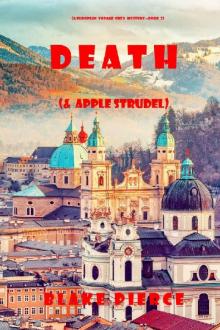- Home
- Blake Pierce
Crime (and Lager) (A European Voyage Cozy Mystery—Book 3) Page 4
Crime (and Lager) (A European Voyage Cozy Mystery—Book 3) Read online
Page 4
“You don’t know, do you?”
Amy had seemed awfully gleeful about something she was keeping secret from London. Or was Amy keeping a secret at all? Had she just found a new way to push London’s buttons?
Don’t let it get to you, she told herself.
That’s exactly what she wants.
Soon London heard the comforting rumble of Sir Reggie’s soft snoring. And yet she still couldn’t quite get to sleep. Finally, she realized what was on her mind.
Mom.
London’s mother had left her father and sister and her back when she was fourteen. She’d said she was going on a trip to Europe, but she disappeared without a trace. Whatever had happened to Mom had been a family mystery for years. But the day before yesterday, back in Salzburg, something had changed.
A woman named Selma had said she’d gotten to know Mom while she’d been living in Salzburg, working as a language tutor. According to Selma, when Mom left she’d said she was on her way to Germany. The woman hadn’t heard from her since.
And now I’m in Germany, London realized.
Not that it really made any difference. London had no idea where in Germany Mom might be—or if she was still in Germany at all. She might be anywhere in the world as far as London knew.
She remembered what Selma had said when London asked if Mom had ever talked about her family.
“Whenever she tried to talk about you, she’d look like she was about to cry.”
So why had Mom left in the first place—and why hadn’t she come back, or at least told somebody where she’d gone and why?
It was late now, and London reminded herself that she needed her sleep. The Nachtmusik would arrive in Regensburg early tomorrow, and she and Emil would be leading a tour for the passengers.
She had to wonder, were she and the historian even still friends?
How would he behave when they were working together tomorrow?
CHAPTER FIVE
“It’s been said that the devil himself has snatched certain souls from this very bridge,” the ship’s historian declared.
London joined in the general gasp of surprise. She and Emil were beginning their tour with twenty passengers from the Nachtmusik, and his words were quite startling on such a pleasant morning in this charming city. She looked over the faces in the group, some more familiar than others. Walter and Agnes Shick, a kindly elderly couple, were among them, as well as the less friendly Audrey Bolton. They were all about to step onto a wide stone structure built across the Danube River.
London herself didn’t happen to know anything about the devil and this ancient bridge.
“And so, ladies and gentlemen,” Emil continued, “you might want to exercise some caution before you walk across. Just a fair warning in case you would rather not take any chances. Would anybody like to go back to the ship?”
Of course, most of the passengers looked more amused than alarmed at the historian’s announcement. They knew what London knew. With his characteristic dryness, Emil was teasing them with the promise of a good story, and nobody raised their hand wanting to go back.
“Ah, an intrepid group indeed,” Emil said. “Well, let us plunge on into today’s adventure, shall we?”
As they walked toward the picturesque buildings, towers, and spires of Regensburg on the other side of the river, London was pleased to see that Emil seemed to be in a good mood now. He hadn’t joined her for breakfast in the Habsburg Restaurant as she’d hoped he would, and he’d barely said a word to her since they’d come ashore.
His silence worried her—not just because she didn’t know why he was acting like this, but because it hampered their working relationship. She’d come along on the tour, as usual, to back him up and to help out with whatever the passengers might need. She had even left Sir Reggie back on the boat so she could concentrate on her job.
But she felt that the easy rapport she and Emil had developed while leading tours in other cities was missing. They both knew a lot about European locales and history, and usually they were able to slyly cue each other with a word or a nod or a smile as to which of them should do the talking at any moment.
Right now she sensed no such clues from Emil. Although he was walking right at her side, he was acting as if she wasn’t there at all.
Even so, London thought it was probably time for her to chip in.
Smiling at the group, she said, “Well, I don’t happen to know about any danger of having our souls snatched by the devil. I hope Emil will explain that before we get all the way across. But I can tell you that we are now walking across almost nine centuries of European history.”
A murmur of interest passed among the tourists.
London pointed east where the morning sun glistened on the Danube.
“Before this bridge existed, the emperor Charlemagne himself built a wooden bridge over there, about three hundred feet downstream. That bridge didn’t last, and this one was built between 1135 and 1146—a true masterpiece of medieval engineering that made Regensburg a cultural center that linked Venice with Northern Europe. Until about a hundred years ago, this was the only bridge across the Danube between Ulm and Vienna.”
London pointed at a statue of a nearly naked young man mounted above the balustrade at the bridge’s highest point. He was shielding his eyes with his hand and seemed to be looking toward a pair of spires in the Old Town.
“Perhaps Emil could tell us something about that interesting character,” she said.
Emil nodded to her rather coolly, then broke into a smile again as he spoke to the group.
“He’s called the Brückenmännchen, which means ‘bridge mannequin,’ and he’s mounted on top of what appears to be a little toll booth. But don’t worry, there’s no charge for crossing the bridge, at least not now.”
Walking closer to the statue, Emil explained, “The Brückenmännchen is thought to represent the young engineering prodigy who is said to have built the bridge in the first place. As you can see, he is looking over at the two spires of St. Peter’s Cathedral. According to legend, he had good reason to keep his eye on those spires.”
Emil leaned against the balustrade as the others in the group gathered around him to listen. London, too, was intrigued.
He continued, “Back in Regensburg’s early days, a master builder and his young apprentice each took charge of two crucial construction projects. The master set to work building that cathedral over there, while his apprentice started building this bridge. The apprentice was rather—how do you say it in English?—‘full of himself.’ So he made a bet that he could finish building the bridge before the master could finish the cathedral.”
Emil crossed his arms and chuckled.
“Ah, the arrogance of youth! Of course the young man soon fell behind schedule. Realizing that he was going to lose his bet, he summoned up the devil himself and made a deal with him. The devil said he would help him finish the bridge on time, but only if the apprentice promised he could take the first three souls to cross the bridge. The deal was signed—in blood, I suppose, as deals with the devil usually are. Naturally, the devil expected those souls to be very valuable indeed—presumably the mayor, the duke, and the bishop.”
Emil smiled impishly at the group and said teasingly, “Oh, but I don’t want to bore you with the rest of this silly story.”
London laughed and said, “Don’t you dare stop now!”
Emil looked over the group, apparently ignoring London’s comment. But when several of the tourists eagerly agreed, he continued.
“Well, the devil sped the construction of the bridge along, and as completion neared, the young apprentice started feeling guilty about the deal he had made. He sought out a priest and confessed what he had done. Fortunately, the priest was a very smart fellow, and he noticed that the devil had unwittingly left a loophole in his contract.”
Emil paused and smiled.
“Well, what was the loophole?” one of the tourists demanded.
“Yes,
tell us!” another said.
“Unfortunately for the devil,” Emil said, “he did not specify that the souls promised to him had to be human souls.”
Emil then pointed to several peculiar statues that ranged along the bridge.
“You may have noticed the statues of certain creatures that have been fashioned here. Among them you’ll see a donkey, a dog, and a goose. The apprentice made sure that they were the first three creatures to cross that bridge, and the devil wound up with their measly souls. He was furious, of course. And it is said that he still lurks beneath one of the bridge’s arches sulking over how he was cheated, causing navigational problems with eddies and whirlpools like those you can see right below us.”
London and the group lined up along the balustrade and looked down into the river. Sure enough, the water swirled menacingly around the pilings of each of the arches.
Emil finished his little lecture by saying, “Ever since then, the Danube has been hard to navigate along this stretch. Just ask our captain. He’ll tell you it isn’t easy sailing.”
Indeed, London was aware that the Nachtmusik had had difficulties in docking. She thought that some of the passengers had probably also noticed the slight bumpiness of the ship’s early morning maneuvers.
The group broke into delighted chatter about the legend they’d just heard.
London found herself impressed by Emil anew.
He’s quite a storyteller, she thought.
She asked Emil jokingly, “Has the devil actually snatched any other souls off this bridge?”
“None that I know of,” Emil said.
“Well, after almost nine hundred years, I imagine the coast is clear,” London said to the group. “Come on, let’s head on over into Old Town.”
At the far end of the bridge, the group walked through an arch under a clock tower. As they continued along the street, several of the passengers came to a sudden halt.
“Oh, my!” one exclaimed. “What’s that delicious smell?”
“The whole city smells like sausages!” another said.
London laughed. She knew that they were passing near one of the most historic restaurants in the world. But she considered it too soon after breakfast to stop there now—especially since beer was an outstanding part of the menu.
“It’s a famous sausage kitchen,” London told them. “We can come back later for lunch.”
Several grumbling passengers broke away from the group and headed toward the restaurant anyway. And as London expected, a few of the others broke away from the tour to go exploring on their own. It made for a smaller and more manageable group for London and Emil to escort on into the city.
Their first destination was an ancient archway amid ruined walls and towers. The ruins of massive stone were eerily embedded in the walls of a building that must have been built there many hundreds of years later.
London explained, “This is the Porta Praetoria, the gate of the northern wall of an ancient Roman camp called the Castra Regina, which means ‘fortress by the river Regen.’”
Emil added, “It was built in 179 A.D. by the Roman emperor Marcus Aurelius. It is one of only two surviving Roman gates north of the Alps.”
Then they led their charges a short distance to St. Peter’s Cathedral, with its Gothic spires and its tall facade adorned with statues.
Before they entered, London smiled as she told the others, “I’m afraid the legend he told about this cathedral and the bridge can’t be entirely accurate. You see, construction on this church started in 1260—more than a hundred years after the completion of the Stone Bridge. So there couldn’t very well have been a race to get them built.”
“And probably no deal with the devil, I suppose,” Emil added dryly. “A pity.”
He turned abruptly and strode away.
London hurried after him. She had only intended to point out that the contradiction in dates that made the legend historically inaccurate—as many legends were. But she had managed to annoy the historian again.
Apparently not noticing the tension, the tourists laughed and followed London and Emil into the nave with its arched, vaulted ceiling, its beautiful stained glass windows, and its countless carved images of St. Peter. Before they left the cathedral, they stopped to look at one of its most famous features—a charming statue of a smiling angel gazing protectively down from high on one of the pillars.
Their walking tour continued west through Regensburg’s narrow, weaving streets and frequent plazas to the Old Town Hall, a three-building complex of Baroque and Gothic architectural styles with a tall, ornate clock tower. Emil led the way into an enormous old meeting chamber with severe-looking wooden benches and a high timbered ceiling.
Emil explained, “Between 1663 until 1806, this was the meeting place for the Imperial Diet, a governing body of the Holy Roman Empire. Certain German phrases originated here. For example, am grünen tisch sitzen—‘to sit at the green table’—means to take part in important decisions.”
Putting his hand on the back of a bench, he added with a grin, “And on those extremely rare occasions when a German procrastinates, we say he’s putting something on die lange Bank—‘the long bench.’”
Emil and London then led the group down into the cellars below the Old Town Hall, where they stepped onto a gallery overlooking a torture chamber. A veritable factory of horrors, the room was cluttered with familiar grim devices like stocks and the rack, but also with stranger tools and machines too frightening even to think about how they must have been used.
Emil explained, “It was here that heretics were forced to confess before they were sentenced to death. I don’t imagine many of them held out too long before confessing to whatever heresies they were supposedly guilty of.”
It was a relief to climb out of the dank cellar and step into the cheerful, sunlit streets again. As the tour continued south, one of the tourists called out.
“Listen! Do you hear that?”
London stopped walking and listened. For a moment, she couldn’t hear anything over the sound of traffic and chattering pedestrians.
But then she heard it too—the sound of music wafting through the air.
It certainly wasn’t the kind of music she’d have expected to hear in a historical town like Regensburg.
For a moment, London wondered whether she might be dreaming.
What is that music, exactly? she wondered, as she hurried in that direction.
And why are we hearing it here?
CHAPTER SIX
The bright, cheerful, and rather rowdy music sounded oddly out of place here among the quaint, stately, antique buildings of Regensburg. London noticed that several in the group were looking around with confusion on their faces. A few broke into laughter, apparently enjoying the contrast. Others, including Audrey Bolton, seemed less happy with the sounds.
But then, London thought, I’ve never seen Audrey look happy with anything.
Emil seemed to be the only person in the group who wasn’t at all startled.
“Ah, I think I know what we are hearing,” Emil said with a smile. “Follow me.”
He led the way along a short, narrow street into a bustling square called the Neupfarrplatz. A small ensemble performing there included trumpets, trombones, a sousaphone, a clarinet, a banjo, and even a washboard being used as a percussion instrument. Other people gathered in the square seemed to be thoroughly enjoying the sounds those musicians were making.
“I believe we are hearing an American form of jazz called ‘Dixieland,’” Emil said, speaking above the boisterous music. “And the tune, if I am not mistaken, is ‘That’s a Plenty,’ and it was composed by Lew Pollack in 1914. Just listen to that web of intertwined melody lines—counterpoint, it’s called. It is as intricate in its way as the Baroque music of Bach, Handel, or Vivaldi.”
After pausing to listen for a moment, he added, “This particular type of performance, if I’m not mistaken, is Dutch ‘old-style jazz,’ which evolved in the Low Countri
es about the same time that the earliest American jazz was taking shape. Such American jazz greats as Cab Calloway and Duke Ellington gave some of their finest concerts in the Netherlands.”
Tilting his head judgmentally, Emil added, “Call me a snob if you like, but I prefer traditional New Orleans style to this European offshoot. Still, this is better than no jazz at all.”
I shouldn’t be surprised, London told herself. Although the ship’s historian sometimes seemed a bit stuffy, he had already proven himself a man of wide and eclectic tastes. She felt her admiration for Emil building up again. She missed the friendship they had shared, and wondered why he was being so touchy lately.
When the tune came to an end, Emil continued his little lecture as the instrumentalists readied for their next number.
“Although Regensburg is a long way from the Low Countries—and even farther away from America—it is quite an important European jazz center. My guess is that this ensemble is in town preparing for the upcoming annual Bavarian Jazz Weekend, when about a hundred bands from all over the world will congregate here in Regensburg. I understand the city can get especially lively then.”
Emil nodded with approval as the band launched into another sprightly tune.
“Ah, the celebrated ‘Tiger Rag.’ An excellent selection. Alas, we do not have time to stay and listen. As you know, our ship is scheduled to move on this afternoon. Our time in Regensburg is short, and right now we must make a rendezvous with history.”
Two more of their group waved goodbye and stayed right there, listening to the music. But London felt a tingle of excitement about their next stop on the tour—a literal descent into Regensburg’s past.
At the southern end of the square, she and Emil led the group down a staircase and into a concrete tunnel with bare light bulbs hanging overhead.
Taking her turn at lecturing, she told the group, “We are walking through an air raid bunker used by the Nazis during World War Two,” she said. Pointing to a row of stenciled letters along the wall, she added, “The word you see repeated here is Neupfarrplatzgruppe, the name of a resistance group that fought against the Nazis. The name has been written over and over again in their honor.”

_preview.jpg) Once Gone (a Riley Paige Mystery--Book #1)
Once Gone (a Riley Paige Mystery--Book #1) Left to Hunt (An Adele Sharp Mystery—Book Nine)
Left to Hunt (An Adele Sharp Mystery—Book Nine) Left to Kill (An Adele Sharp Mystery—Book Four)
Left to Kill (An Adele Sharp Mystery—Book Four) LURING
LURING If She Hid
If She Hid If She Fled
If She Fled Already Gone (A Laura Frost FBI Suspense Thriller—Book 1)
Already Gone (A Laura Frost FBI Suspense Thriller—Book 1) Vengeance in Vienna
Vengeance in Vienna Once Shunned
Once Shunned Left To Run
Left To Run Face of Fury (A Zoe Prime Mystery--Book 5)
Face of Fury (A Zoe Prime Mystery--Book 5) Blake Pierce - Kate Wise - 5 - If She Fled
Blake Pierce - Kate Wise - 5 - If She Fled IF SHE RAN
IF SHE RAN Left to Envy (An Adele Sharp Mystery—Book Six)
Left to Envy (An Adele Sharp Mystery—Book Six) Silent Neighbor
Silent Neighbor Her Last Wish (A Rachel Gift FBI Suspense Thriller—Book 1)
Her Last Wish (A Rachel Gift FBI Suspense Thriller—Book 1) Almost Lost
Almost Lost Before He Harms
Before He Harms Murder (and Baklava) (A European Voyage Cozy Mystery—Book 1)
Murder (and Baklava) (A European Voyage Cozy Mystery—Book 1) Left to Vanish (An Adele Sharp Mystery—Book Eight)
Left to Vanish (An Adele Sharp Mystery—Book Eight) THE PERFECT IMAGE
THE PERFECT IMAGE The Perfect Affair (A Jessie Hunt Psychological Suspense Thriller—Book Seven)
The Perfect Affair (A Jessie Hunt Psychological Suspense Thriller—Book Seven) Left To Die
Left To Die BEFORE HE LAPSES
BEFORE HE LAPSES Left to Prey (An Adele Sharp Mystery—Book Eleven)
Left to Prey (An Adele Sharp Mystery—Book Eleven) The Perfect Neighbor (A Jessie Hunt Psychological Suspense Thriller—Book Nine)
The Perfect Neighbor (A Jessie Hunt Psychological Suspense Thriller—Book Nine) Almost Dead
Almost Dead The Perfect Wife
The Perfect Wife The Perfect Smile
The Perfect Smile If She Saw
If She Saw Left To Die (An Adele Sharp Mystery—Book One)
Left To Die (An Adele Sharp Mystery—Book One) City of Prey: An Ava Gold Mystery (Book 1)
City of Prey: An Ava Gold Mystery (Book 1) Stalking
Stalking Face of Darkness (A Zoe Prime Mystery—Book 6)
Face of Darkness (A Zoe Prime Mystery—Book 6) The Perfect Mistress (A Jessie Hunt Psychological Suspense Thriller—Book Fifteen)
The Perfect Mistress (A Jessie Hunt Psychological Suspense Thriller—Book Fifteen) Girl, Vanished (An Ella Dark FBI Suspense Thriller—Book 5)
Girl, Vanished (An Ella Dark FBI Suspense Thriller—Book 5) The Perfect Block
The Perfect Block Left to Fear (An Adele Sharp Mystery—Book Ten)
Left to Fear (An Adele Sharp Mystery—Book Ten) Almost Gone (The Au Pair—Book One)
Almost Gone (The Au Pair—Book One) The Perfect Facade (A Jessie Hunt Psychological Suspense Thriller—Book Twelve)
The Perfect Facade (A Jessie Hunt Psychological Suspense Thriller—Book Twelve) The Perfect Affair
The Perfect Affair Once Chosen (A Riley Paige Mystery—Book 17)
Once Chosen (A Riley Paige Mystery—Book 17) Girl, Alone (An Ella Dark FBI Suspense Thriller—Book 1)
Girl, Alone (An Ella Dark FBI Suspense Thriller—Book 1) Face of Murder (A Zoe Prime Mystery—Book 2)
Face of Murder (A Zoe Prime Mystery—Book 2) The Perfect Mistress
The Perfect Mistress Crime (and Lager) (A European Voyage Cozy Mystery—Book 3)
Crime (and Lager) (A European Voyage Cozy Mystery—Book 3) Before He Harms (A Mackenzie White Mystery—Book 14)
Before He Harms (A Mackenzie White Mystery—Book 14) Face of Fear
Face of Fear Left to Murder (An Adele Sharp Mystery—Book Five)
Left to Murder (An Adele Sharp Mystery—Book Five) Left to Vanish
Left to Vanish The Perfect Secret (A Jessie Hunt Psychological Suspense Thriller—Book Eleven)
The Perfect Secret (A Jessie Hunt Psychological Suspense Thriller—Book Eleven) The Perfect Deceit (A Jessie Hunt Psychological Suspense Thriller—Book Fourteen)
The Perfect Deceit (A Jessie Hunt Psychological Suspense Thriller—Book Fourteen) Blake Pierce - The Making of Riley Paige - 4 - Taking
Blake Pierce - The Making of Riley Paige - 4 - Taking Death (and Apple Strudel) (A European Voyage Cozy Mystery—Book 2)
Death (and Apple Strudel) (A European Voyage Cozy Mystery—Book 2) THE PERFECT HOUSE
THE PERFECT HOUSE Cause to Save
Cause to Save Face of Fear (A Zoe Prime Mystery—Book 3)
Face of Fear (A Zoe Prime Mystery—Book 3) Stalking (The Making of Riley Paige—Book 5)
Stalking (The Making of Riley Paige—Book 5) A Neighbor's Lie
A Neighbor's Lie The Perfect Neighbor
The Perfect Neighbor Once Dormant
Once Dormant A Trace of Crime
A Trace of Crime CAUSE TO DREAD
CAUSE TO DREAD Already Missing (A Laura Frost FBI Suspense Thriller—Book 4)
Already Missing (A Laura Frost FBI Suspense Thriller—Book 4) Waiting
Waiting If She Knew
If She Knew If She Feared (A Kate Wise Mystery—Book 6)
If She Feared (A Kate Wise Mystery—Book 6) Left To Run (An Adele Sharp Mystery—Book Two)
Left To Run (An Adele Sharp Mystery—Book Two) Left to Lapse (An Adele Sharp Mystery—Book Seven)
Left to Lapse (An Adele Sharp Mystery—Book Seven) If She Hid (A Kate Wise Mystery—Book 4)
If She Hid (A Kate Wise Mystery—Book 4) The Perfect Alibi (A Jessie Hunt Psychological Suspense Thriller—Book Eight)
The Perfect Alibi (A Jessie Hunt Psychological Suspense Thriller—Book Eight) Once Taken
Once Taken Before He Envies
Before He Envies Before He Sins
Before He Sins Mackenzie White 07-Before He Sins
Mackenzie White 07-Before He Sins ONCE BOUND
ONCE BOUND Once Buried
Once Buried Waiting (The Making of Riley Paige—Book 2)
Waiting (The Making of Riley Paige—Book 2) Riley Paige 11-Once Buried
Riley Paige 11-Once Buried Once Forsaken (A Riley Paige Mystery—Book 7)
Once Forsaken (A Riley Paige Mystery—Book 7) Once Stalked (A Riley Paige Mystery—Book 9)
Once Stalked (A Riley Paige Mystery—Book 9) The Perfect Disguise (A Jessie Hunt Psychological Suspense Thriller—Book Ten)
The Perfect Disguise (A Jessie Hunt Psychological Suspense Thriller—Book Ten) ONCE TRAPPED
ONCE TRAPPED Watching
Watching Keri Locke 02-A Trace of Muder
Keri Locke 02-A Trace of Muder Cause to Hide
Cause to Hide Once Hunted
Once Hunted Cause to Kill (An Avery Black Mystery—Book 1)
Cause to Kill (An Avery Black Mystery—Book 1) Before He Preys
Before He Preys Once Pined
Once Pined A Trace of Hope
A Trace of Hope Once Craved (a Riley Paige Mystery--Book #3)
Once Craved (a Riley Paige Mystery--Book #3) Once Lured
Once Lured Before He Sees (A Mackenzie White Mystery—Book 2)
Before He Sees (A Mackenzie White Mystery—Book 2) Before he Kills (A Mackenzie White Mystery—Book 1)
Before he Kills (A Mackenzie White Mystery—Book 1) Keri Locke 03-A Trace of Vice
Keri Locke 03-A Trace of Vice Once Cold
Once Cold ONCE LOST
ONCE LOST Before He Takes
Before He Takes Before He Covets (A Mackenzie White Mystery—Book 3)
Before He Covets (A Mackenzie White Mystery—Book 3) BEFORE HE NEEDS
BEFORE HE NEEDS